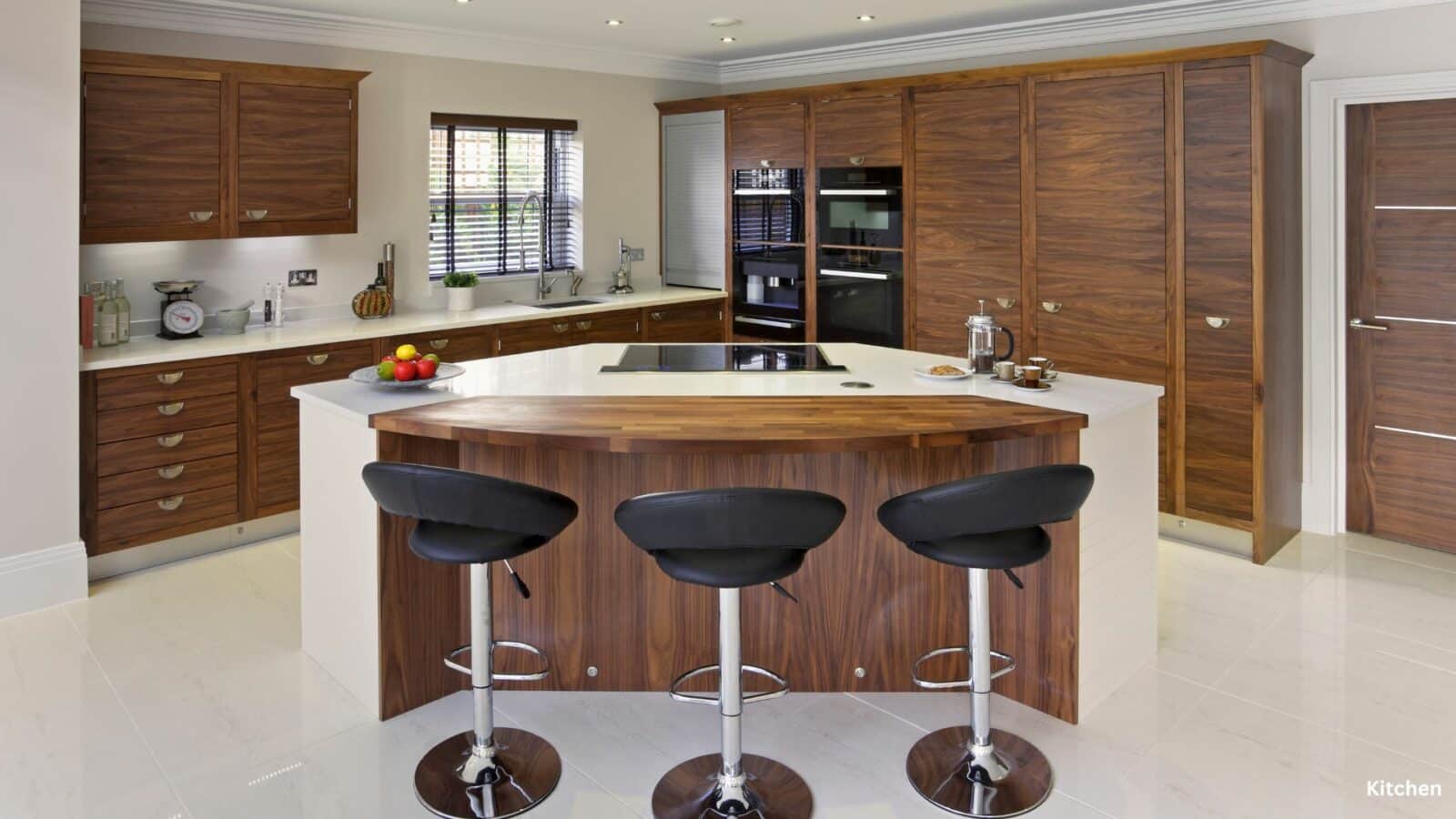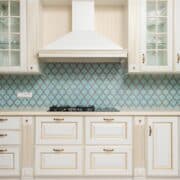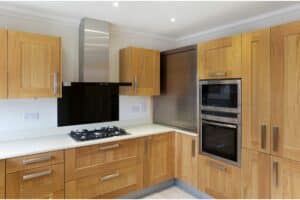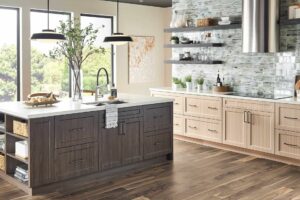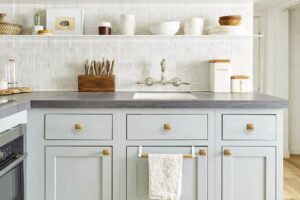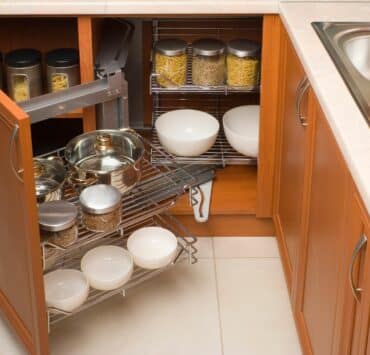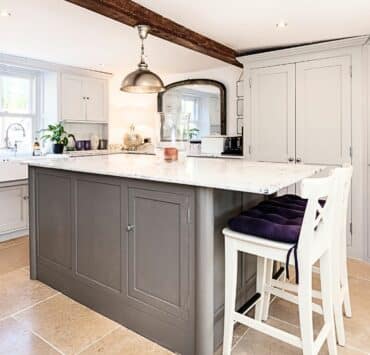Are you considering a kitchen renovation? One of the essential elements of a kitchen makeover is choosing the perfect cabinets. In recent years, walnut kitchen cabinets have become a popular choice for homeowners who desire a modern yet timeless look. This article will delve into everything you need to know about walnut kitchen cabinets, including the pros, cons, maintenance tips, pricing, and frequently asked questions. Let’s dive in!

Pros of Walnut Kitchen Cabinets
- Durability: Walnut wood is known for its strength and resilience, making it an excellent choice for kitchen cabinetry. This hardwood can withstand daily wear and tear, ensuring your cabinets stay looking great for years to come.
- Unique Grain Pattern: One of the most attractive features of walnut wood is its distinct wood grain. Each walnut kitchen cabinet boasts a unique pattern, giving your kitchen a one-of-a-kind look.
- Timeless Appeal: Walnut wood has been a popular choice for centuries, and it’s not going out of style anytime soon. Whether you opt for modern walnut kitchen cabinets or a more traditional design, these cabinets will remain stylish for years to come.
- Versatility: Walnut wood pairs well with various styles and color schemes. From modern minimalism to classic farmhouse, walnut kitchen cabinets can adapt to suit your design preferences.

Cons of Walnut Kitchen Cabinets
- Price: Walnut wood is considered a premium material, and as such, walnut kitchen cabinets tend to be more expensive than those made from more common materials, like oak or maple.
- Darkening Over Time: Walnut wood tends to darken over time with exposure to sunlight, so you might notice a slight color change in your cabinets as the years pass. This is not necessarily a disadvantage, but something to be aware of.
- Susceptible to Scratches: While walnut is a strong and durable wood, it can be susceptible to scratches and dents. Proper care and maintenance can help minimize these issues.

How to Clean and Care for the Cabinets
- Regular Dusting: Use a soft, dry cloth to dust your walnut kitchen cabinets regularly. This helps remove any debris and dirt that can accumulate on the surface and in the wood grain.
- Gentle Cleaning: For spills or stains, use a damp cloth with mild soap and water. Avoid using harsh chemicals, as they can damage the wood’s finish.
- Repair Scratches: If you notice scratches on your walnut kitchen cabinets, you can use a wood filler or putty in a matching color to repair them. Be sure to follow the product’s instructions for best results.
- Protect from Sunlight: To prevent your walnut cabinets from darkening over time, consider using window coverings to protect them from direct sunlight.

Cost
-
Material and Basic Costs:
- For basic walnut cabinets, the material costs can range from $368 to $520 per linear foot.
- Higher-end walnut cabinets, especially those made from premium or custom-designed walnut, can cost significantly more. Fully customized walnut cabinets can range from $15,000 to $30,000 or more for a full kitchen.
-
Installation Costs:
- The cost of installing walnut kitchen cabinets typically ranges from $50 to $200 per linear foot depending on the complexity of the installation and the labor costs in your area.
- The total cost for a medium-sized kitchen (around 20 linear feet of cabinetry) could range from $5,000 to $13,000, including both materials and labor.
-
Customization and Quality:
- Stock walnut cabinets are the most affordable, ranging from $100 to $300 per linear foot installed. Semi-custom cabinets can cost between $200 to $500 per linear foot installed, while fully custom cabinets can reach $500 or more per linear foot.
- Higher quality woods such as black walnut are more durable and can add a luxurious feel to the kitchen but will increase the cost.
-
Additional Features:
- Extra features like custom hardware, pull-out racks, and other accessories will add to the overall cost. For example, a pull-out spice rack can cost between $200 and $500, while under-cabinet lighting may add another $200 to $350 per fixture.
Walnut Cabinet Styles
Walnut kitchen cabinets come in various styles that can cater to different design preferences. Here are some popular styles to consider:
Modern Walnut Kitchen Cabinets

Modern walnut kitchen cabinets focus on simplicity, clean lines, and showcasing the natural beauty of the wood. These cabinets often have flat-panel doors, which create a smooth, unadorned appearance. The hardware is usually minimalistic, with slim handles or knobs in metallic finishes like chrome or brushed nickel. Modern walnut cabinets can be used in various kitchen designs, including contemporary, industrial, and minimalist spaces. The rich walnut wood adds warmth and visual interest to these sleek designs, making them a popular choice among homeowners who appreciate a refined, uncluttered aesthetic.
Shaker Walnut Kitchen Cabinets

Shaker-style walnut kitchen cabinets are characterized by their straightforward design and practicality. They feature recessed-panel doors with a simple frame, emphasizing clean lines and functionality. Shaker cabinets often have modest hardware, such as round knobs or simple handles, in finishes like matte black, brushed nickel, or antique brass. This versatile cabinet style complements a wide range of kitchen designs, including farmhouse, transitional, and even modern spaces. Shaker walnut cabinets offer a timeless, classic appeal, making them an excellent choice for homeowners who want a versatile and enduring design.
Mid-Century Modern Walnut Kitchen Cabinets
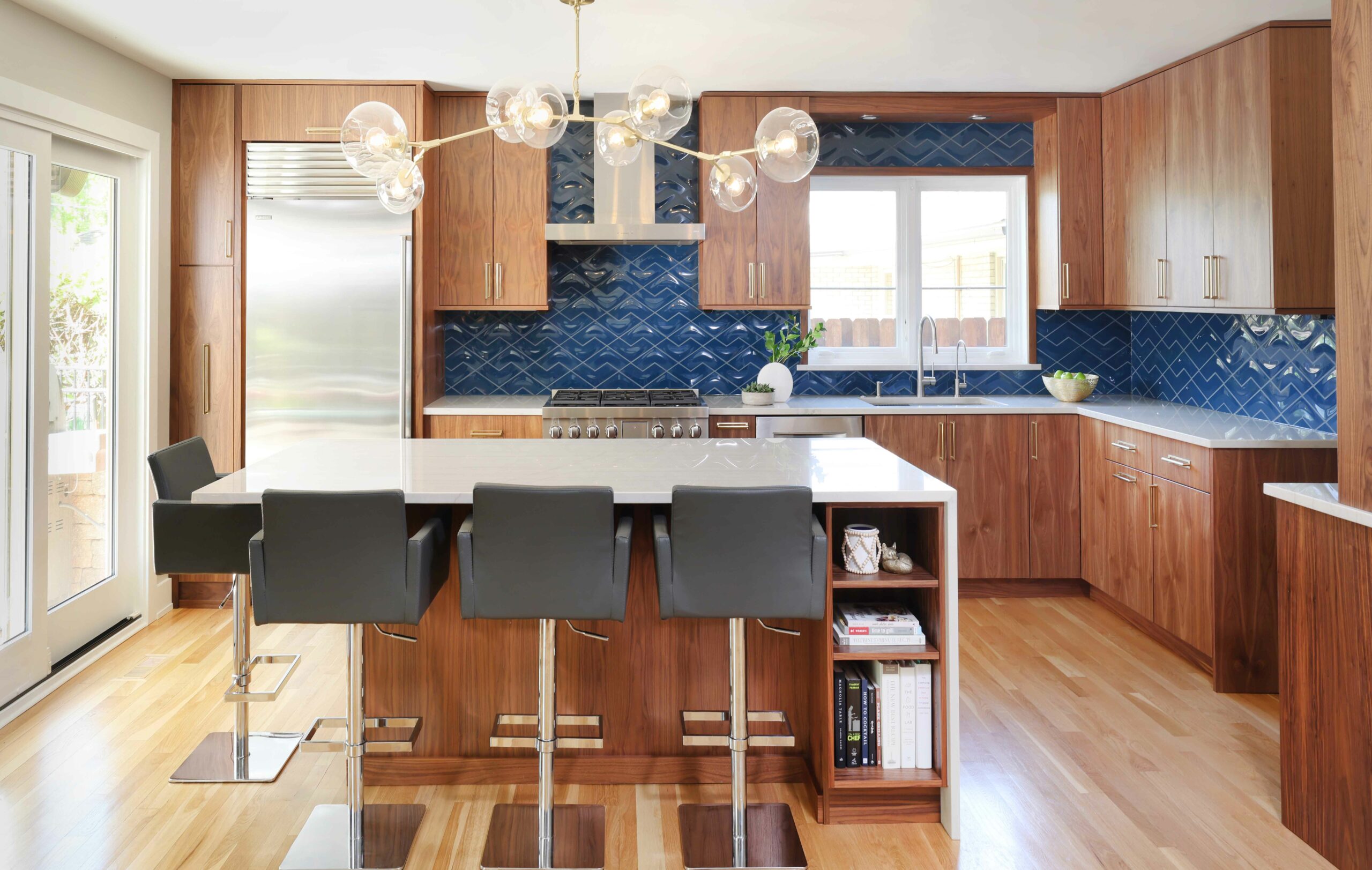
Mid-century modern walnut kitchen cabinets capture the essence of the mid-20th-century design movement, which emphasized clean lines, organic shapes, and minimal ornamentation. These cabinets often have slab doors that highlight the walnut’s natural grain and color. The hardware used in mid-century modern cabinets is typically angular or geometric, with finishes like brushed brass or chrome. This retro-inspired style is perfect for homeowners who want to create a kitchen with a nod to the past while still feeling fresh and contemporary. Pair mid-century modern walnut cabinets with other design elements from the era, such as colorful appliances, funky light fixtures, and bold patterns, to create a cohesive look.
Traditional Walnut Kitchen Cabinets
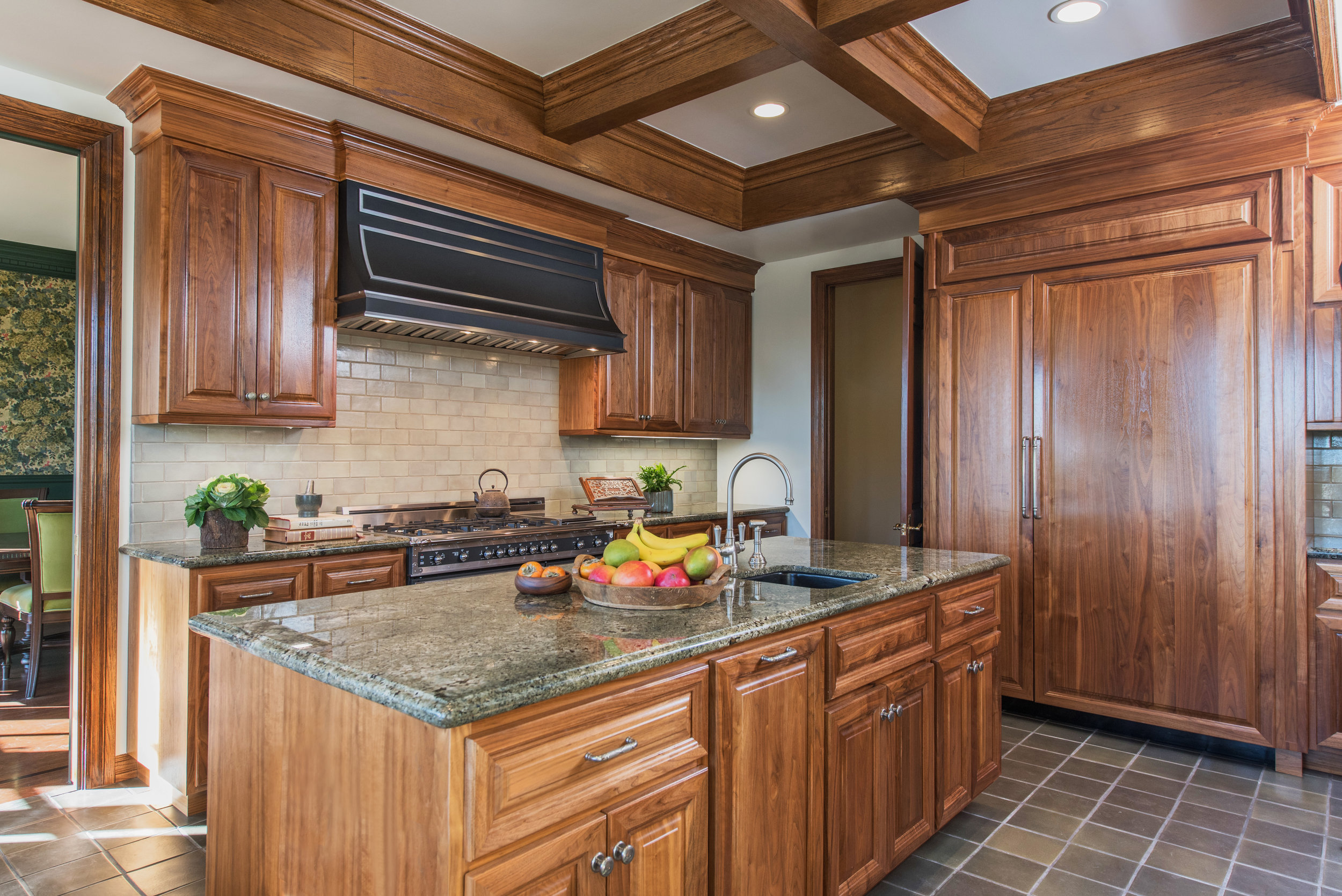
Traditional walnut kitchen cabinets are known for their elegant, intricate details and classic design elements. These cabinets often feature raised-panel doors with decorative molding, ornate hardware, and elaborate woodwork. The rich, dark hues of the walnut wood pair well with the sophisticated details, making traditional walnut cabinets a popular choice for those who want an upscale, refined kitchen. To complete the traditional look, pair walnut cabinets with luxurious materials like marble or granite countertops, ornate tile backsplashes, and elegant lighting fixtures.
Two-Tone Walnut Kitchen Cabinets
Two-tone walnut kitchen cabinets are an excellent option for homeowners looking to create visual interest and a unique, dynamic design. This style involves combining walnut cabinets with cabinets in a different wood type or color. For instance, you can use walnut cabinets for your lower cabinets and pair them with lighter wood or painted upper cabinets. Alternatively, you can use walnut cabinets for your kitchen island and a different material or color for the surrounding cabinets. Mixing and matching walnut cabinets with other finishes can create a striking contrast and add depth to your kitchen design. This approach works well in various kitchen styles, from contemporary to transitional and eclectic spaces.
Hardware and Accessories
Choosing the right hardware and accessories can significantly impact the overall look of your walnut kitchen cabinets. Here are some suggestions:
- Hardware: When selecting hardware for your walnut cabinets, consider the style and finish that will best complement your kitchen design. Popular choices include brushed nickel, matte black, or brass hardware.
- Countertops: Walnut cabinets pair well with a variety of countertop materials, including natural stone, quartz, and laminate. Lighter countertops can create a stunning contrast with the dark wood, while darker countertops can create a more cohesive, monochromatic look.
- Backsplash: A well-chosen backsplash can tie your kitchen design together. Consider using neutral tones or materials like subway tile, glass, or natural stone that will complement your walnut cabinets.
- Flooring: The right flooring can enhance the beauty of your walnut kitchen cabinets. Options include hardwood, tile, and luxury vinyl plank flooring. Keep in mind the color and style of your cabinets when selecting a flooring material.
Customization Options for Walnut Cabinets
Many manufacturers offer customization options for walnut kitchen cabinets. These options allow you to create a kitchen that is uniquely yours:
- Cabinet Door Styles: Choose from various door styles, including flat-panel, shaker, raised-panel, and more, to achieve your desired look.
- Finish Options: While natural walnut wood is stunning on its own, you can also opt for stained or painted finishes to alter the wood’s appearance or add a protective layer.
- Storage Solutions: Incorporate built-in storage solutions such as pull-out shelves, drawer organizers, and lazy Susans to maximize functionality and organization in your kitchen.
- Custom Sizing: If you have unique spatial requirements or design preferences, many manufacturers offer custom sizing options to ensure your walnut kitchen cabinets fit perfectly in your space.
Frequently Asked Questions
1. Are walnut kitchen cabinets suitable for all kitchen styles?
Yes, walnut kitchen cabinets are versatile and can complement a variety of kitchen styles, from modern to traditional. Shaker walnut kitchen cabinets, for example, are an excellent choice for a classic or farmhouse kitchen, while sleek, flat-panel designs work well in contemporary spaces.
2. How do walnut kitchen cabinets compare to other wood types?
Walnut is a premium hardwood known for its durability, unique grain pattern, and rich color. It is generally more expensive than other wood types, such as oak or maple. While each wood type has its own distinct characteristics and benefits, walnut cabinets offer a luxurious, timeless appeal that is hard to match.
3. Do walnut cabinets require more maintenance than other wood cabinets?
Walnut kitchen cabinets do not necessarily require more maintenance than other wood cabinets. However, it is essential to clean and care for them properly to maintain their beauty and longevity. Regular dusting, gentle cleaning, and protecting them from direct sunlight will help keep your walnut cabinets looking their best.
4. Can I mix and match walnut cabinets with other wood types in my kitchen?
Absolutely! Mixing and matching different wood types can create a unique and dynamic look in your kitchen. Walnut kitchen cabinets can be paired with lighter wood types, such as maple or oak, for an interesting contrast. You can also mix walnut cabinets with painted cabinets to create a more eclectic design.
Walnut kitchen cabinets offer a beautiful and timeless addition to any kitchen renovation. With their unique grain patterns, rich color, and durability, they can elevate your space and adapt to various design styles. Keep in mind the potential drawbacks, such as the higher price point and susceptibility to scratches. Proper care and maintenance can help you enjoy your walnut kitchen cabinets for years to come. Whether you’re going for a modern look with flat-panel designs or prefer the classic appeal of shaker walnut kitchen cabinets, this investment will undoubtedly enhance the beauty and value of your home.
